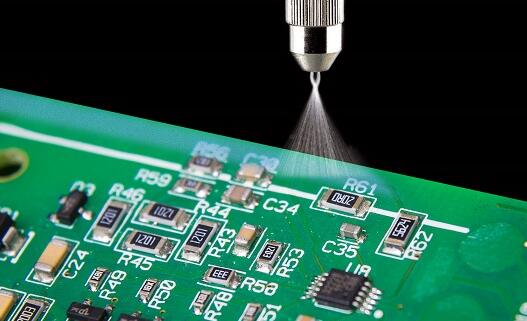PCB coating is a special paint used to protect circuit boards and related equipment from environmental erosion. PCB coating has good resistance to high and low temperatures; After curing, it forms a transparent protective film, which has superior insulation, moisture resistance, leakage resistance, shock resistance, dust prevention, corrosion resistance, aging resistance, corona resistance, and other properties.

PCB coating is used on electronic circuit boards and components to enhance their moisture and pollution resistance, prevent erosion of solder joints and conductors, shield and remove electromagnetic interference, and prevent circuit board short circuits, thereby improving the insulation performance of circuit boards.
PCB coating is used to protect circuit boards from moisture, salt spray, static electricity, salt spray, humidity, electrical insulation, dust, vibration, and harsh environmental impacts such as high and low temperatures.
PCB coating for PCB boards usually refers to the moisture, dust, and corrosion resistance of the PCB.
1) Moisture-proof: PCB moisture-proof refers to protecting the PCB board from moisture, humidity, and moisture erosion. Moisture and humidity may cause corrosion, short circuits, or failure of metal components (such as solder joints, wires, etc.) on the circuit board. Damp-proof paint can form an isolation layer on the surface of the PCB, blocking the invasion of moisture and humidity, and providing additional protection.
2) Dust prevention: PCB dust prevention refers to protecting the PCB board from dust, particulate matter, and other impurities. Dust and particulate matter may adhere to circuit boards, affecting the performance of electronic components, and even causing short circuits or malfunctions. Dustproof paint can form a layer of cover to prevent dust and impurities from entering the PCB surface.
3) Corrosion prevention: PCB corrosion prevention refers to protecting PCB boards from corrosion caused by chemicals, corrosive gases, and humidity. Some environmental conditions may cause corrosion of metal components on PCBs, thereby reducing their performance or lifespan. Anti-corrosion paint can form a protective layer on the surface of PCB, blocking the erosion of harmful substances and providing corrosion resistance.
PCB coating spraying process
1. Cleanliness requirements: Before applying the PCB coating, ensure that the surface of the PCB is clean and free of dust, oil, and other pollutants. Suitable cleaning agents and tools can be used for cleaning to ensure the adhesion and quality of the paint film.
2. Spraying environment requirements: Generally, spraying should be carried out in a clean room or spraying equipment with constant temperature and humidity to avoid the impact of dust, impurities, and humidity on the quality of the paint film.
3. Spraying equipment and process parameters: Select suitable spraying equipment and spray gun to ensure uniform and consistent coating. Spraying process parameters such as spraying speed, spraying distance, and spraying angle also need to be set according to specific recommendations for the three prevention paint products.
4. Coating layer thickness control: It is very important to control the coating layer thickness of the PCB coating. An excessively thick coating may cause uneven drying and curing, and even affect the installation of components on the circuit board.
5. Drying and Curing: After spraying, the drying and curing process needs to be carried out. Depending on the specific PCB coating product, it may be necessary to bake or cure under specific temperatures and time conditions to ensure that the paint film has good physical and chemical properties.
PCB coating is a very important protective measure that can protect circuit boards from moisture, corrosion, and dust. Not only can it extend the service life of the circuit board, but it can also improve the working stability of the circuit board in harsh environments.